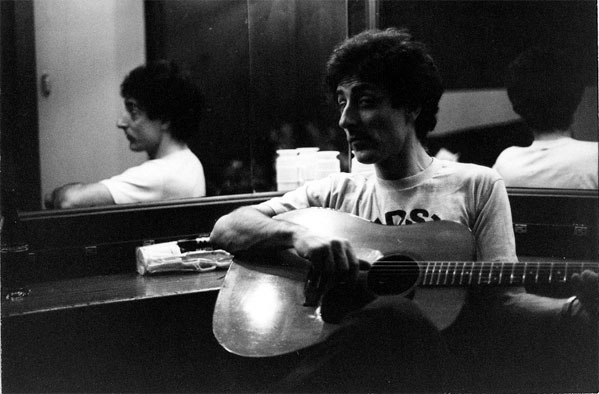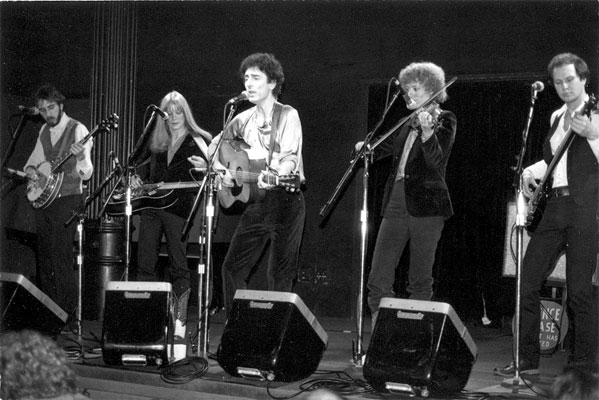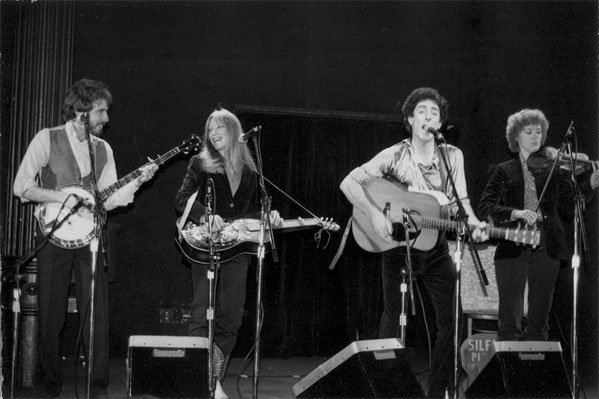John Herald (of The Greenbriar Boys)
interviewed in 1981

John Herald is perhaps best known as the guitarist and lead singer of The Greenbriar Boys. Together with the Country Gentlemen, they were the leaders of what was referred to at the time (which is to say the early ’60s) as the urban Bluegrass revival.
Their approach was certainly different to that of traditional Bluegrass groups, being distinguished by a great deal of originality.
But they did not last a long time, and soon passed into a moment (albeit a very significant one) of musical history, leaving behind a mere three LPs and a performance on Pete Seeger’s Rainbow Quest TV program.
I caught up with John at a performance in New York with his new band, and took the chance to ask him both where he had been and where he was going:

How did you first get interested in Bluegrass, John?
Well, I know the first record I ever bought was a country music record: it was Bluebird On My Windowsill by Slim Whitman or Montana Slim, something like that (I probably bought that when I was ten years old). And then I lost sight of Country Music, of course, because there wasn’t too much around New York. Until I heard a show one day on the radio, coming from either Hackensack or Hoboken, called The Home Town Frolic, with a fellow by the name of Don Larkin. And every day, just when I’d happen to be off from high school for lunchtime, he’d come on with about fifteen minutes of Bluegrass. And that was the first time I ever heard Bluegrass, and I just went bananas.
This would be in—what? The mid-50s?
Yeah, I’d say about ’56, ’57.
Because Bluegrass was very much a minority interest at that time, wasn’t it?
Was it! I had not the slightest idea how to find it or who knew anything about it—this was in my senior year in high school.
And then, as luck would have it, that very summer, before I went to college, my father took me down to Washington Park (which is here in Greenwich Village) and there was a fellow by the name of Roger Sprung, who was probably the first banjo-picker in New York, and Eric Weissberg and Marshall Brickman, and a fellow by the name of Bob Yellin. And I watched them, and after coming around in the summer quite a few times, I sort of got to know them. Turned out Eric Weissberg, Marshall Brickman and myself were all going to be freshmen at the University of Wisconsin; and there I followed them around like a puppy dog. I was completely in awe and they were very open. I was up at the house a lot, just watching and listening and they were playing all kinds of Don Reno & Red Smiley records, and Lester Flatt & Earl Scruggs. And then Eric showed me a couple of guitar chords. When that school year was over I persuaded my father to give me $50 for a guitar. At the time we were living on 13th Street & 3rd Avenue, the heart of the Bowery. And that was also Pawnshop Row. So I went down and looked into a few of the pawn-shops; saw this beautiful little sunburst Gibson, which I got for $50, came home, put my fingers on the thing with maybe the three chords that I knew, and began to play, and I knew right there I wasn’t going back to college.
So did this lead directly to The Greenbriar Boys?
Well, that summer (which was my next summer of knowing about Bluegrass) was when we formed The Greenbriar Boys with Eric Weissberg and Bob Yellin. So that group continued for a little while, we didn’t get any work, we just played mainly at Washington Square Park. Eric Weissberg’s mother gave the name to the group (from a song called The Greenbriar Shore), and Eric had his fingers in a few different pies, and he left; and that was when we got Ralph Rinzler, who had just come back from England, as a matter of fact. And as soon as we formed a group with him, and started playing at Washington Square, that was when we got out first job, at a place called Gurdy’s Folk City, which was right across the street from here. So that was the start of The Greenbriar Boys.
OK, you made—let’s see—three records, is that right?
We made three Greenbriar Boys records, then there’s a Best of, and then there’s—our first actual record was ¼ of a record. We were ¼ of the participants, with 4 acts on the record: it was The Greenbriar Boys, Hedy West, David Gould and Jackie Washington. And that record was called New Folks.
And I believe you also backed Joan Báez on a couple of tracks on one of her LPs?
Yeah, that was just about the same time, that first year that we recorded. She asked us to tour with her too, so we did a lot of that with her.

Why did you break up?
Well, there were several reasons. Mainly, well, to begin with, Ralph Rinzler, as much as he loves the music, he’s probably as dedicated as anybody I’ve ever seen, preferred to further the music scholastically and through the Smithsonian Institute in Washington, rather than be a player. He was interested in getting Bill Monroe going, and Doc Watson was just being discovered (by the way, that’s a very interesting story, I tell you, exactly how Doc Watson was discovered).
Then we got Frank Wakefield. So he was directly from the South, and I guess we played about 50-50, about 3 years with Ralph and 3 or 3½ with Frank. About that time the Beatles were just starting to come in, there was no huge light at the end of the tunnel, and in other ways our work was sort of leveling off. About that time Bob Yellin had met a lady who was a banjo-player and had gotten him an offer to go with an Israeli group. He did, and soon moved to Israel. And that was sort of the beginning of the end of the Greenbriar Boys.
Usually if there’s a page on The Greenbriar Boys, it will include the fact that we had won the Best Band competition at a place called Union Grove, which was, up until about two years ago, the oldest fiddlers’ convention in the South. We found out about it in 1959, and went down there because we wanted a dose of the Real McCoy. And we happened to win the Best Band competition, and Bob won the Best Banjoist competition. Then we went down the next year or the year after, I’m not exactly sure. And the way Union Grove ran at that time was, it was at the Union Grove School. And there were two separate contests: one was in the school auditorium, which was very small and held about 500 people; and the bigger part was out in this huge tent that would fit a few thousand people. They used to put the bands that were in the competition into different classrooms to warm up, and there would sometimes be two to four bands in one classroom. So, we had rehearsed, and then I went around to look in the other classrooms to see what the bands were like. And I got way down to the opposite end of the hall from where we were, and there was this old fellow sitting there, picking a banjo, with a couple of other guys. They were quite… I don’t now if you can picture a Mountain Look, but this was a Mountain Look. So I asked somebody who it was, and they said Clarence Ashley, and that sort of rang a bell to me.
So I went back to the classroom and found Ralph Rinzler, and I said “There’s a guy down there called Clarence Ashley, didn’t you say something about Carolina Tar Heels or something like that?” And Ralph’s jaw dropped and his eyes lit up, and he went racing down to that classroom and there of course was Clarence Ashley from the old Carolina Tar Heels, which is one of the better-known Old Timey groups. He immediately made a date to come up and record Clarence Ashley…
And that was the Old Time Music at Clarence Ashley’s LP, is that right?
That’s it. And there was Doc Watson playing guitar for Clarence Ashley. And then Ralph began to manage Doc, and The Watson Family, and Clarence Ashley. And Bill Monroe shortly thereafter.

You’ve been in Bluegrass, what, about 20 years? How do you think it’s changed over that period?
Well, as in most other groups’ music, it’s losing its spunk, I think its earthiness, its primitiveness, its rawness. I don’t find most of the Bluegrass bands playing with the beat that they used to. Nowadays the voices sound a lot more trained, a lot of the bands are closer to an Eagles’ sound. But for myself, I’m very excited about Old-Time music. I’ve seen some young Old-Time bands that are coming from New York, all over, that just raise the hair on the back of my neck, they’re so good.
Who are some of your favorites among the current bands? Or the old bands, for that matter?
My favorite singer of all time is Riley Puckett, of Gid Tanner and the Skillet Lickers: he’s the only person I consciously tried to copy. There was Don Reno who was my guitar influence early on…
Don Reno? On guitar?
Oh, yes, some of his early records are really hot stuff. Doc, of course, floored me and everybody else when we heard him; and I tried to learn from Doc, but I have a different wrist and arm. Although we do both play somewhat straight-armed: most Bluegrass and Country guitar-players play using their wrist. We both have sort of an arm attack, more with our forearm; but I could never master Doc’s attack on the guitar.
Doc transcends musical categories really, he just plays everything he happens to like, Carl Perkins, Elvis Presley, whatever…
Right. So for singing, Riley Puckett, and Don Reno for guitar. Since then, of course, there’s scads of people I like… Do you just mean in the Bluegrass category?
No, in any field.
Well, lately I’ve been very excited about a fellow I discovered a couple of years ago called Washboard Sam—as a matter of fact we’ll be doing a couple of tunes tonight, one that I got from him, and a song that I wrote, from a feeling I got just listening to him.
And then Bill Monroe, consciously or unconsciously, has done something I would like to do: he brought a lot of Blues into Bluegrass, and I’d like to do the same. Of course, we’re not really just Bluegrass any more, we do Country and Cajun and Folk Music as well. Right now I’m trying to achieve, in an acoustic context, an eclectic attitude—almost playing all forms of Country Music except Country Rock, and possibly Swing.

Discography
Vinyl
The Greenbriar Boys (vinyl)
| Year | ID | Title | Discogs | Comments |
|---|---|---|---|---|
| 1961 | Vanguard VSD-2097 | Joan Baez, Vol. 2 | Buy LP | Two tracks feature The Greenbriar Boys. |
| 1962 | Vanguard VRS-9104 | The Greenbriar Boys | Buy LP | |
| 1963 | Elektra EKL-233 | Dian & the Greenbriar Boys | Buy LP | Re-released on CD in 2006. |
| 1964 | Vanguard VSD-79159 | Ragged But Right! | Buy LP | |
| 1966 | Vanguard VSD-79233 | Better Late Than Never | Buy LP |
John Herald (vinyl)
| Year | ID | Title | Discogs | Comments |
|---|---|---|---|---|
| 1973 | Paramount PAS 6043 | John Herald | Buy LP |
The John Herald Band (vinyl)
| Year | ID | Title | Discogs | Comments |
|---|---|---|---|---|
| 1978 | Bay Records BAY 213 | John Herald and the John Herald Band | Buy LP | |
| 1984 | Rooster RSTR 126 | The Real Thing | Buy LP |
CD
John Herald (CD)
| Year | ID | Title | Discogs | Comments |
|---|---|---|---|---|
| 2000 | Spit & Polish SPITCD 003 | Roll On John | Buy CD |
Video
The Greenbriar Boys (DVD)
| Year | ID | Title | Amazon | Comments |
|---|---|---|---|---|
| 1966(?) | Shanachie 608 | Pete Seeger’s Rainbow Quest | Buy DVD | The later incarnation, with Frank Wakefield. |